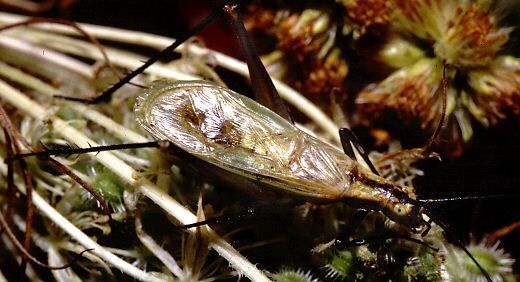species
Oecanthus nigricornis Walker, 1869
black-horned tree cricket

Nomenclature (28)
- Oecanthus nigricornis Walker, 1869: 93. (valid)
Holotype; female; NHMUK015982402; deposited at: Natural History Museum, London (NHMUK); United States: Illinois
- Oecanthus nigricornis Walker, 1869 in Beutenmüller, 1894: 270.
- ... Show all ... (24)
- Oecanthus nigricornis Walker, 1869 in Mhatre, Pollack & Mason, 2016
- Oecanthus nigricornis Walker, 1869 in Collins & Lightfoot, 2022: 186, 187.
Nomenclature references (28)
- Alexander, R.D. (1962) Evolutionary change in cricket acoustical communication. Evolution, 16, 443–467. Available at http://entnemdept.ifas.ufl.edu/walker/Buzz/k340la62b.pdf
- Beutenmüller, W. (1894) Descriptive catalogue of the Orthoptera found within fifty miles of New York City. Bulletin of the American Museum of Natural History, 6(Article XII), 253–316, plates V-X. Available at http://hdl.handle.net/2246/1570
- ... Show all ... (24)
- Walker, T.J. (1963) The taxonomy and calling songs of United States tree crickets (Orthoptera: Gryllidae: Oecanthinae). II. The nigricornis group of the genus Oecanthus. Annals of the Entomological Society of America, 56, 772–789. Available at http://entnemdept.ifas.ufl.edu/walker/Buzz/s576lw63.pdf
- Walker, T.J. (1966) Annotated checklist of Oecanthinae (Orthoptera: Gryllidae) of the World. The Florida Entomologist, 49(4), 265–277. Available at http://hbs.bishopmuseum.org/fiji/pdf/walker1966.pdf
Descendants and synonyms
Stats
| Valid names | |||||
|---|---|---|---|---|---|
| Rank | Extant | Fossil | Invalid | Total | |
| species | 1 | 0 | 1 | 2 | |
